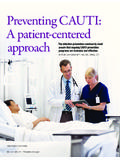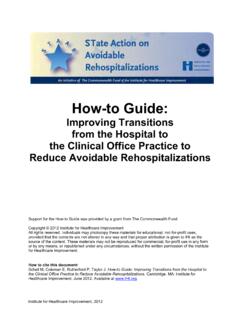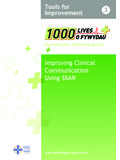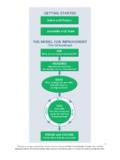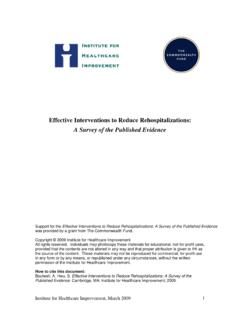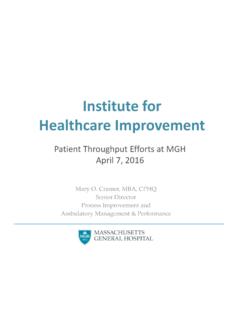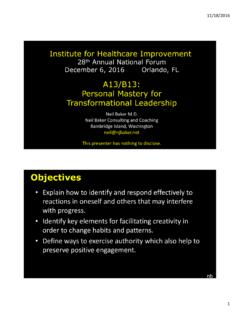Transcription of Antibiotic Stewardship Driver Diagram and Change Package
1 Antibiotic Stewardship Driver Diagram and Change Package Introduction Prepared by the institute for healthcare improvement (IHI) Prepared for the Centers for Disease Control and Prevention (CDC) A Framework to Reduce Inappropriate Antibiotic Utilization in Hospitals The Centers for Disease Control and Prevention (CDC) and the institute for healthcare improvement (IHI) partnered in an effort to develop this conceptual model of key drivers for reducing inappropriate Antibiotic utilization.
2 Content experts contributed to the development of this robust Driver Diagram and Change Package with a recognition and emphasis on practicality and ease of implementation in all A Driver Diagram is a tool to help organize our theories and ideas in an improvement effort as we answer what Change can we make that will result in improvement ? The initial Driver Diagram for an improvement project might describe the descriptive theory of improved outcomes that can then be tested and enhanced to develop a predictive theory. The Driver Diagram should be updated throughout an improvement effort and used to track progress in theory buildingi. Pilot Testing: From September 2011 to June 2012, CDC and IHI worked with eight hospitals on pilot testing the enclosed set of recommendations to assess the feasibility of implementation in hospitals of varying size, acuity, and location. The Driver Diagram and Change Package were modified based on that pilot testing.
3 How to Use The Driver Diagram and Change Package : The Driver Diagram attempts to lay out the various processes that can lead to optimal Antibiotic use. The broad categories of these processes are referred to as Primary and Secondary drivers . The Change Package outlines a number of specific interventions that have either been demonstrated to or experts believe will positively impact the drivers . The ultimate goal is to use the interventions in the Change Package to drive improved Antibiotic use. We do not recommend that any facilty attempt to implement all of the interventions at once. There are a large number of interventions outlined in the Change Package , and attempting to implement too many at one time will likely create huge challenges. Rather, the Change Package is meant to serve as a menu of options from which facilities can select specific inerventions to improve Antibiotic use. Selection of specific interventions to implement should be tailored to the areas that most need improvement at each facility.
4 Facilities should assemble a multi-disciplinary team of physicians, pharmacists, nursing, microbiology and administration to discuss the aspects of Antibiotic use that are most in need of improvement . The team can then select specific interventions from the Change Package to address those issues. It is important to select the interventions that are most supported by clinical staff. It is essential to monitor and measure. The Driver Diagram and Change Package come with a Measurement Framework, which suggests various measures of Antibiotic use that might be useful to assess the effectiveness of improvements. Just as important is the measurement of small tests of Change to assess the implementation of interventions. Reviews of small numbers of charts or discussions with clinicians can identify potential barriers to implementation. 2 July 2012 Update Antibiotic Stewardship drivers and Change Package | Prepared by the institute for healthcare improvement Antibiotic Stewardship Change Package 3 July 2012 Update Antibiotic Stewardship drivers and Change Package | Prepared by the institute for healthcare improvement Overarching Driver : Leadership and Culture Secondary Driver Key Change Concepts Specific Change Ideas Promote a culture of optimal antibiotici use within the facility Engage administrative and clinical leadership to champion Stewardship effort 1.
5 Identify clinical providers as champions to be thought leaders about Antibiotic Stewardship . 2. Work with administrators to ensure that they understand the rationale and goals for Stewardship programs and interventions so that they can provide support (financial and non-financial). 3. Engage a physician champion and core team to enhance the focus of antimicrobial Stewardship into the current process of care. 4. Bring disciplines together to improve communication and collaboration about improving Antibiotic use, including, as appropriate: Infection preventionists; Hospitalists; Intensivists; Emergency department physicians; Microbiologists; Pharmacists; Nurses; and Infectious disease experts. 5. Consider having the multidisciplinary group perform a gap analysis of antimicrobial use at the facility to identify priority areas for improvement . 4 July 2012 Update Antibiotic Stewardship drivers and Change Package | Prepared by the institute for healthcare improvement Primary Driver 1: Timely and Appropriate Initiation of Antibiotics Secondary Driver Key Change Concepts Specific Change Ideas Promptly identify patients who require antibiotics Develop a standardized process to identify patients who require antibiotics 1.
6 Develop standardized diagnostic criteria for identifying patients with signs and symptoms suggesting specific types of infection ( , community acquired pneumonia (CAP), urinary tract infection (UTI), skin/soft tissue infection (SSTI), bloodstream infection (BSI), sepsis etc). These criteria should also clearly specify situations when antibiotics are not indicated ( non-infectious mimics of CAP). 2. Develop evidence-based clinical pathwaysii that guide diagnostic testing and treatment for these common infections. 3. Consider a computerized decision support system to enable physicians to identify which patients require antibiotics. Obtain cultures prior to starting antibiotics Create standardized protocols for ordering and obtaining cultures and other diagnostic tests prior to initiating antibiotics 1. Utilize prompts for obtaining cultures in automated medication dispensing systems available in ED, ICU, etc.
7 2. Develop processes to ensure cultures are properly and consistently ordered that include: Prompts on Antibiotic orders or physician order entry to remind users to obtain appropriate cultures; Culture prompts or default orders incorporated into standardized order sets for various conditions ( , CAP, UTI, SSTI, BSI); Guidance on appropriate specimen type and culture common infections ( , CAP, UTI, SSTI, BSI); Guidance on frequently inappropriate culturing practices ( , swabs of wounds, urine cultures from asymptomatic patients). 3. Develop processes to ensure cultures are properly and consistently obtained that include: Protocols empowering/authorizing nursing staff to obtain cultures if other providers fail to order them when starting antibiotics; Guidance on appropriate specimen collection for specific indications ( , number of blood cultures and volume of blood, cultures for anaerobic pathogens, rapid diagnostic tests); Visual cues in locations near Antibiotic storage reminding staff to ensure cultures have been obtained; Flags or other signal (at the bedside, in the electronic medical record (EMR), in the chart) to make it apparent if cultures have not yet been obtained, and checkboxes indicating that cultures have been obtained; A system to ensure cultures are obtained in patients transferred from the emergency department (ED) to the intensive care unit (ICU) or ward.
8 4. Develop processes to ensure cultures are properly and promptly transported and processed. 5. Develop standards for and assess reliability of processes for ordering and obtaining a culture for the following five steps: Appropriate specimen; Appropriate collection ( , before antibiotics were started); Appropriate labeling; Transport to lab ( , time from obtaining specimen to receipt in lab) Processing of specimen ( , time from receipt in lab to start of processing). 5 July 2012 Update Antibiotic Stewardship drivers and Change Package | Prepared by the institute for healthcare improvement Primary Driver 1: Timely and Appropriate Initiation of Antibiotics Secondary Driver Key Change Concepts Specific Change Ideas Do not give antibiotics with overlapping activity or combinations not supported by evidence or guidelines Develop a way to inform clinicians about unnecessary combinations of antibiotics, including double coverage iii 1.
9 Develop a list of agents that should generally not be combined and develop a mechanism for pharmacy to flag these combinations for review ( , double anaerobic coverage). 2. Leverage the EHR with decision support at the point of care to trigger ABs with overlapping activity or combinations not supported by GLs. 3. Standardize a mechanism for review and follow-up of combinations of agents that are not recommended. 4. Develop evidence-based guidelines for the specific conditions in which combination therapy is recommended and what agents should be combined (based on local formulary and patterns of resistance). In general, use of combination therapy should be limited to empiric coverage of multiple drug resistant organisms (MDROs) prior to obtaining culture results. Determine and verify Antibiotic allergies and tailor therapy accordingly Choose Antibiotic based on patient allergies 1. Consider patient allergies when initiating or changing therapy.
10 2. Ensure that Antibiotic allergies are obtained and documented in the medical record. Documentation should include the Antibiotic and the type of reaction ( , anaphylaxis, rash etc). 3. Incorportate patient allergies as a required field in the EHR (ie: nursing assessment) 4. Ensure Antibiotic allergy history distinguishes true allergies that would preclude use ( , anaphylaxis) from adverse drug reactions ( , diarrhea). Involve patient and family in identifying and confirming allergies; Consider testing for beta-lactam allergy to confirm Antibiotic allergy. 6. Prominently flag medical record or computer order entry system to denote patient allergies to antibiotics. 7. Standardize all hand offs to include assessment and review of patient allergies. Consider local Antibiotic susceptibility patterns in selecting therapy Develop a standardized process for Antibiotic selection 1. Develop facility-specific guidance for diagnosing and treating infections and using antibiotics.












